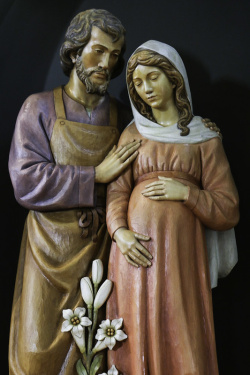
What does it mean to be a disciple?
We might think the answer simple enough: a disciple follows a teacher, so a Christian disciple is one who studies and puts into practice the teachings of Jesus. The problem here, though, is that Jesus isn’t only a wise teacher. To be his disciple requires something more.
At the Great Commission, when he charged his apostles to “go therefore and make disciples,” he made it clear that disciple-making consists of two closely related actions: “teaching” and “baptizing” (Mt 28:19–20). The new disciple needs to be taught, to take upon himself the mind of the Master, to learn to look upon reality as Jesus does. But unlike disciples of merely human teachers, we are also to be joined to him in a profound and real union through the Holy Spirit, so that the Father of Jesus actually becomes our Father. And such a union comes about through baptism.
The disciple, then, lives both in and from this deep union with Jesus.
Pope St. John Paul II once called the Blessed Virgin Mary “the first disciple” and model of all disciples. “She was the first disciple above all else,” he writes, “because no one has been ‘taught by God’ to such depth.”[i] As the first of her son’s disciples and the model for all who will come after her, what can we learn from her discipleship?
First, as Pope Francis explains, “Mary let herself be guided by the Holy Spirit on a journey of faith.”[ii] The words she spoke to Gabriel, “May it be done to me according to your word,” reveal her desire to cooperate with the divine initiative in all things (Lk 1:38). Her words express a response of faith and personal entrustment, two interior movements to be cultivated in the heart of every disciple. Her fiat is made from a posture of freedom and surrender to God, which brings into her life the creative and fruitful movement of the Holy Spirit. The disciple is one who, by the grace of God, becomes radically open to this movement of the Spirit.
Next, if the disciple is one who lives in communion with Jesus, Mary’s discipleship began with the most profound kind of union possible, for her Savior dwelt within her during the months of her pregnancy. As unprecedented and full of wonder as this is, when we receive Jesus in the Holy Eucharist, doesn’t our communion with Jesus in some way parallel Mary’s? We could ask ourselves, with deepest awe for the supreme mystery of our life: What does this mean for me to have Jesus dwelling within? St. Paul says plainly that “Christ in you [is] the hope for glory” (Col 1:27). Mary, the first to enjoy such communion with the second person of the Trinity, shows us how to live this life as Christ-bearers.
Third, for our Lord’s disciples to truly see him, they needed to learn to see in the new way inaugurated by the Incarnation: by seeing through his humanity to his divinity. Mary was the first to learn to see in this way. She gave birth to the Eternal Son of the Father, nursing him, changing his diapers, and raising to manhood the One whom she adored as no other mother has ever adored a child—for she knew him to also be her God and Savior. Mary teaches us, then, in the ordinariness of life, to remain present before the Mystery. As she “kept all these things, reflecting on them in her heart” (Lk 2:19), so should we.
We also learn something important as Mary allows the sword of sorrow and suffering to pierce her heart. While she suffered with Christ at the foot of the Cross, John was given to her—and so she also suffered with John. The disciple is one who knows the suffering of Christ in his Mystical Body and who is intimately acquainted with the sufferings of others. Mary was first in this way of compassion.
Finally, Mary served, bringing Christ to others. While pregnant, she traveled to her cousin Elizabeth to serve her beloved relative in a time of need. She also served the couple in Cana, interceding to Jesus on their behalf. And, as Pope Francis wrote, she served the early Church in its need, too. “She joined the disciples in praying for the coming of the Holy Spirit (Acts 1:14) and thus made possible the missionary outburst which took place at Pentecost.”[iii]
Mary is the model and hope of every disciple. Where her discipleship has led her, we pray one day to be.
Dr. James Pauley is Professor of Theology and Catechetics at Franciscan University and author of two books focused on the renewal of catechesis. He also serves on the USCCB’s executive team for the Eucharistic Revival.
Notes
[i] John Paul II, Catechesi Tradendae, no. 73; cf. Jn 6:45.
[ii] Francis, Evangelii Gaudium, no. 287.
[iii] Ibid., no. 284.
This article originally appeared on page 6 of the printed edition.
Art Credit: Fr. Lawrence Lew, OP, Flickr.com CC
